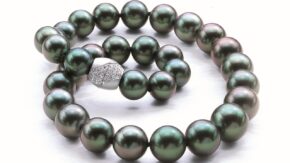A timeline of diamond developments throughout history, from their formation billions of years ago to the first engagement ring and the latest verification tech.
3.5 billion BCE
Canadian diamonds formed 150 kilometers beneath the earth’s surface, with South African diamonds taking shape half a billion years later. In another 2 billion years, the first kimberlite pipes would form.
100 million BCE
Some of the first kimberlite eruptions took place, helping diamonds move toward the surface.
800 BCE
The first diamonds were discovered in India. The earliest known reference to diamonds is in a Sanskrit manuscript dated between 320 and 296 BCE.
327 BCE
Alexander the Great brought the first diamond to Europe from India. By the third century BCE, diamonds were being exported to China.
1330
The European diamond-cutting industry began in Venice, Italy.
1400s
Diamond cutting came to Antwerp in 1447. In 1475, Flemish jeweler Lodewyk van Bercken invented the polishing wheel. In 1477, Archduke Maximilian of Austria gave the first documented diamond engagement ring to Mary of Burgundy. Diamonds were scarce at the time, and it was mostly men who wore them — until Agnès Sorel, mistress of French King Charles VII, set a new trend by sporting diamonds at court.
1725
Artisanal miners in Brazil discovered diamonds while looking for gold. The country was a significant diamond source for the next 150 years.
1800s
In 1867, Erasmus Jacobs found a 21.25-carat diamond — the Eureka (pictured) — on his father’s farm in South Africa. By 1871, the South African diamond rush had begun. In 1886, Tiffany & Co. pioneered the modern diamond engagement ring: a round brilliant stone in an elevated six-prong setting.
1900-1930s
The world’s largest gem-quality diamond was found in South Africa in 1905: the 3,106.75-carat Cullinan, which became part of the British Crown Jewels once cut. Other diamond discoveries in this period included deposits on Namibia’s shores in 1908, and in the Democratic Republic of Congo in 1912. In 1919, Marcel Tolkowsky published Diamond Design, the roadmap for the modern round brilliant cut. But by 1932, diamond mining had declined due to the depressed state of the industry.
1940s-1960s
In 1947, copywriter Mary Frances Gerety penned the slogan “A Diamond Is Forever” for De Beers, injecting new life into the industry. In 1955, the USSR started mining at the Mir deposit, and 1966 saw the discovery of diamonds in Gaborone, Botswana.
1970s-1990s
NASA launched the Pioneer Venus space probe in 1978, encasing its scientific instruments in a titanium shell with diamond windows to protect them from high temperatures and pressure. The same year, Martin Rapaport published the first Rapaport Price List, creating an industry standard for pricing. A year later, diamonds were found at what would become Australia’s Argyle mine, which produced extraordinary pinks, purples and reds.
2000s
The turn of the century saw the formation of the Kimberley Process to prevent trade in conflict diamonds. In 2001, Sarine Technologies developed DiaExpert, the first laser mapping and modeling equipment for rough diamonds. The Gemological Institute of America (GIA) launched its Match iD service in 2022, which verifies that a client’s stone has a grading report.


